Thepla are savory and healthy flatbreads from the Gujarati Cuisine, made with whole grain flours, yogurt, spices, herbs & optional greens. My step-by-step instructions with photos and video will show you how to easily make this classic Thepla recipe with fresh Fenugreek Leaves (Methi). Faintly bitter, tangy and wonderfully spiced, Methi Thepla are delicious to enjoy as a delicious snack any time of the day with your favorite sides.
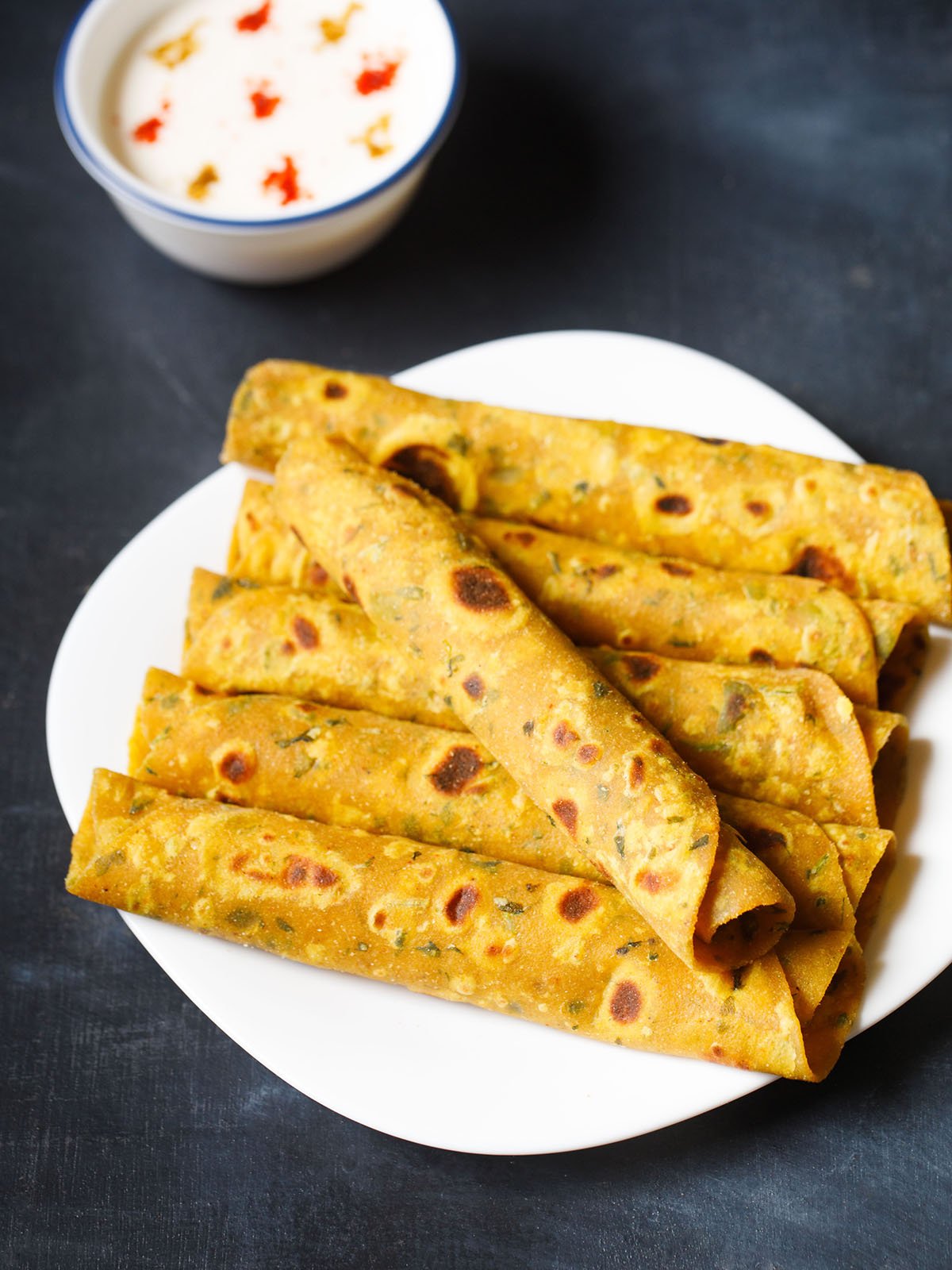
About Methi Thepla Recipe
Thepla are flavorful flatbreads made with an unleavened dough of whole wheat flour, gram flours, spices, herbs, yogurt and optionally millet flours with or without the inclusion of greens or veggies.
Methi Thepla is made with fresh fenugreek (methi) leaves and whole grain flours. These leaves are slightly bitter with a hint of maple, and smell fantastic both raw and when cooked.
Fenugreek also happens to be quite healthy and is known for helping to reduce inflammation and blood sugar levels.
Table of Contents
When combined with spices and a blend of whole wheat flour, gram flour, sorghum flour, and pearl millet flour, the deep earthy taste of the methi is beautifully balanced.
The dough is then flattened, rolled and lightly roasted to create tender and soft flatbreads that are delicious as a snack or a tasty side dish.
Methi Thepla pair well with nearly any savory or sweet dipping sauce, mango pickle, or creamy yogurt.
Continue reading for easy steps and tips (plus video!) for making the best Thepla recipe with fenugreek!
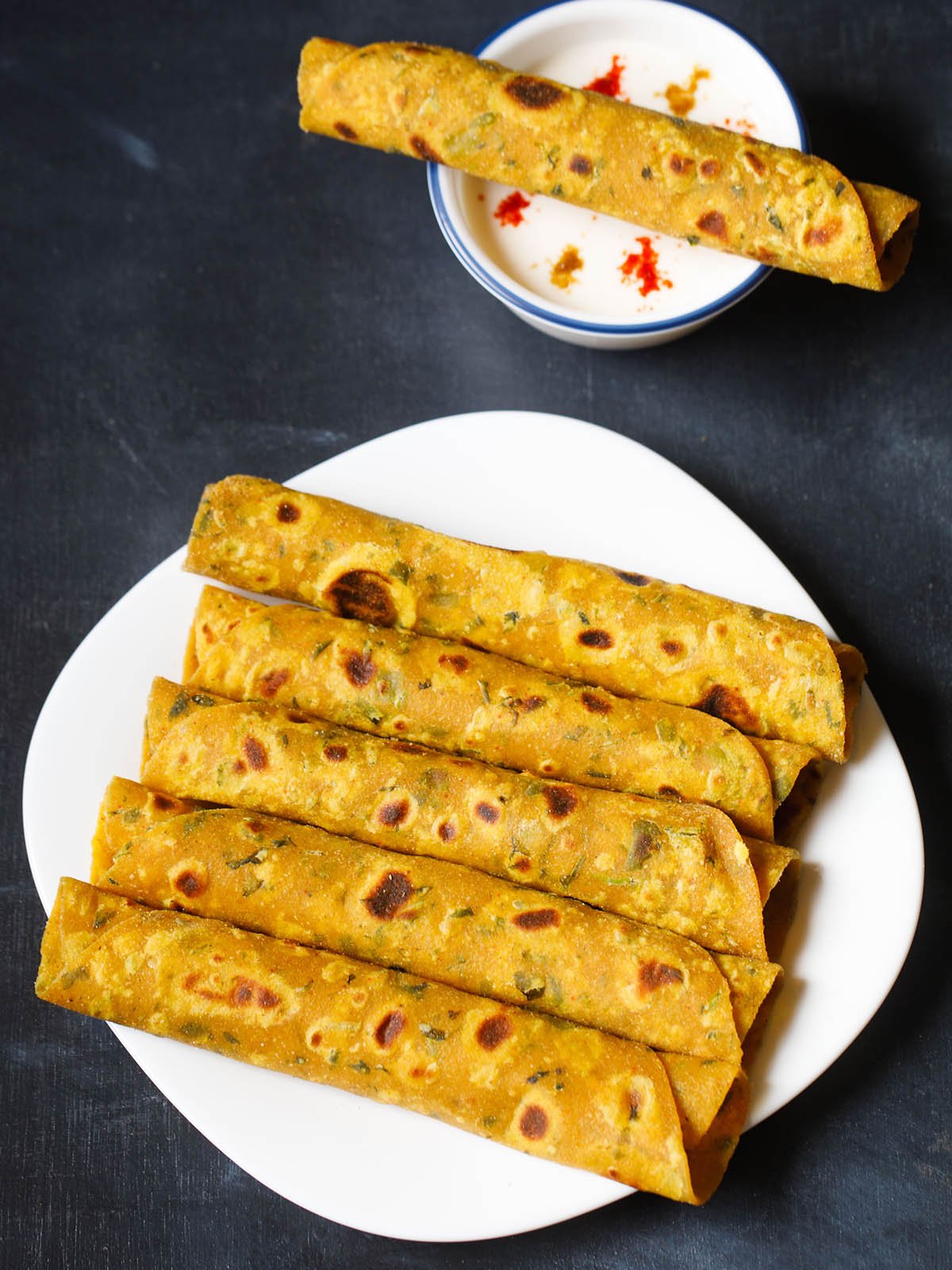
How do you store fenugreek leaves?
As soon as they are purchased and home you should pluck the leaves from the fenugreek stems. Then thoroughly wash and dry the leaves, and keep them in an airtight container or a zip lock bag in the fridge.
I like to keep the plucked methi leaves in a steel container, and the leaves stay fresh for 4 to 5 days. Then whenever I want I can add a sprinkling of methi leaves to pakoras or pulao and even dal.
For more advice for properly cleaning fenugreek leaves be sure to read this Aloo Methi recipe!
How to make Thepla
Prep Methi Leaves
Before you begin making Thepla recipe, you have to prep the methi leaves and make the dough. Pluck the leaves from the stems and tightly pack them in a measuring cup of 240 or 250 ml. Only use the leaves and not the stems.
1. First prepare the fenugreek: Rinse 1 cup of methi leaves very well in cool running water. Then drain them thoroughly and dry with a kitchen towel or paper towel. Chop the leaves finely and set them aside.
Tip: You need to finely chop the methi leaves. If not finely chopped, you will find it difficult to roll the dough and the leaves may tear the dough when rolling.
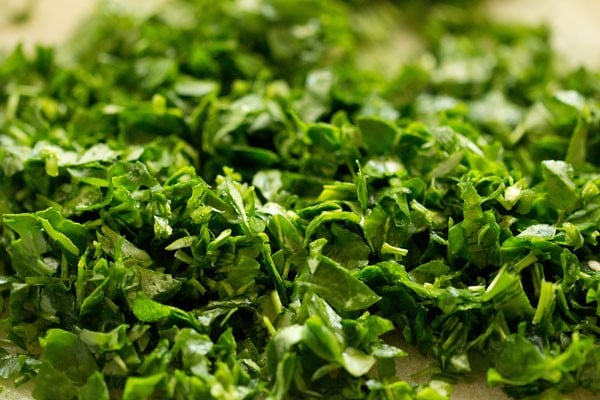
Make Thepla Dough
2. In a large mixing bowl, add the following listed flours:
- 1 cup of whole wheat flour
- ¼ cup besan or gram flour – you can replace it with chickpea flour
- ¼ cup of pearl millet flour also known as bajra atta in Hindi
- ¼ cup sorghum flour called jowar flour or jowar atta
Note that if you don’t have or prefer not to use millet flour – simply leave out and instead add 1¼ cups of whole wheat flour and ½ cup of besan flour.
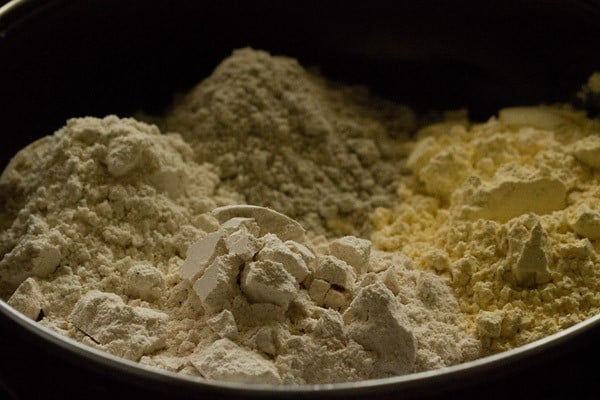
3. Next, add the spices and herbs:
- 1-inch ginger, grated or crushed (in a mortar-pestle)
- 1 or 2 green chilies, crushed – about ½ to 1 teaspoon chopped green chilies or serrano pepper, crushed to a paste (in a mortar-pestle)
- ½ teaspoon red chili powder or cayenne pepper
- ½ teaspoon turmeric powder
- ½ teaspoon cumin powder
- ½ teaspoon coriander powder
- 1 tablespoon oil
- ¾ teaspoon salt or add as required
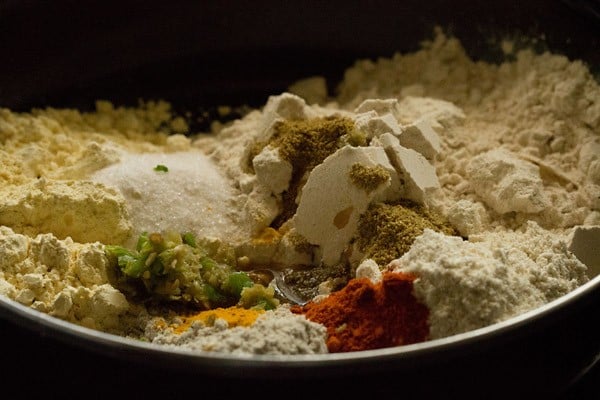
4. Now add the chopped methi leaves.
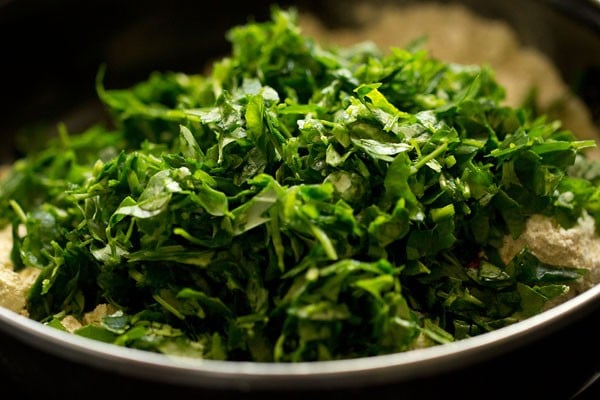
5. Mix everything well.
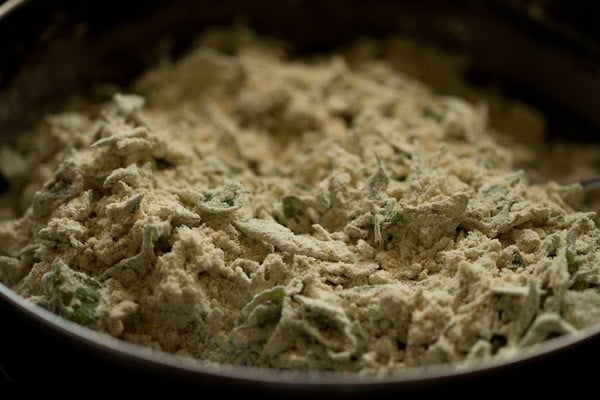
6. Next add 4 to 5 tablespoons of curd or yogurt. To make a plant based version add 4 tablespoons of water or vegan yogurt instead.
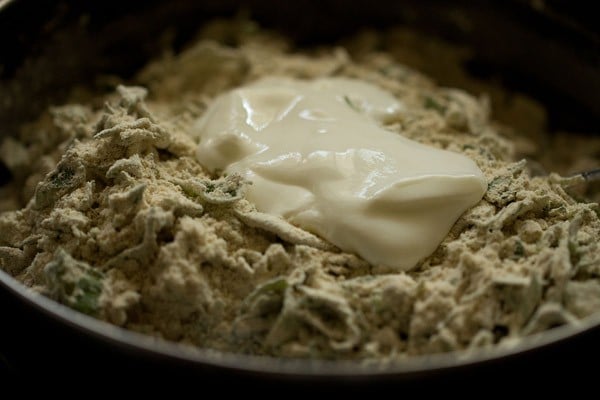
7. Mix again and knead into a dough. Do not add any additional water while kneading, as the methi leaves release water.
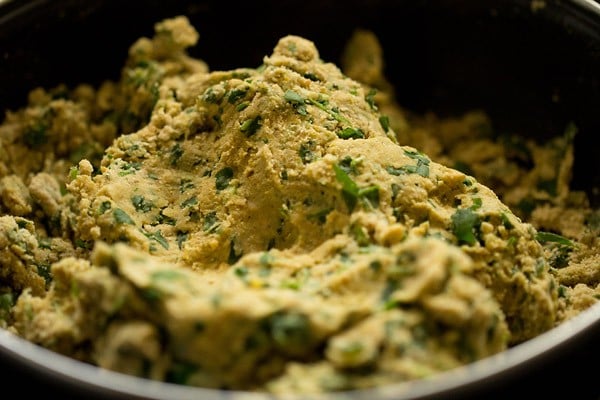
8. Knead very well to form a soft, smooth dough. You can add more curd a tablespoon at a time if required while kneading.
Tip 1: If the dough looks hard, add a few tablespoons of curd and knead.
Tip 2: If the dough becomes sticky, add some wheat flour. Mix and continue to knead.
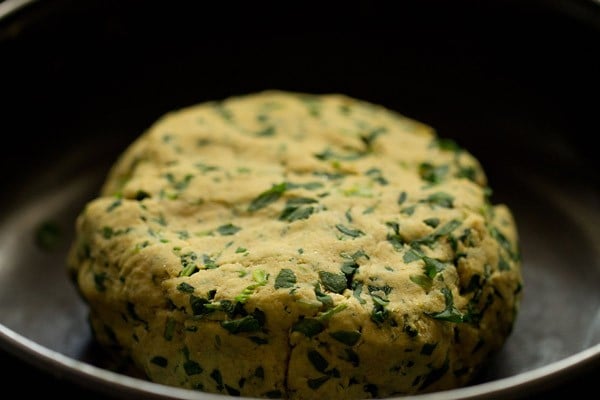
9. Now make 10 or 11 medium sized balls from the dough.
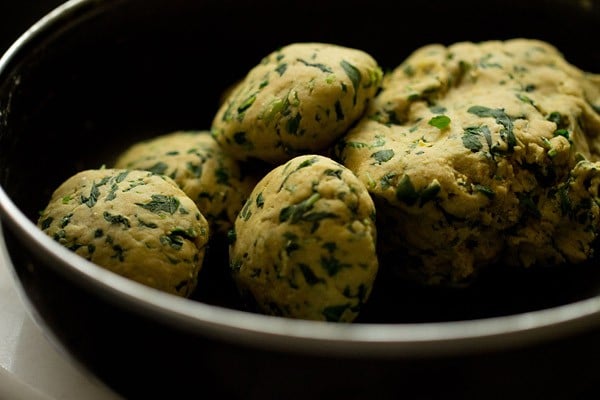
Roll Into Flatbreads
10. Working one at a time, take a dough ball and lightly sprinkle with flour on a clean, lightly floured surface.
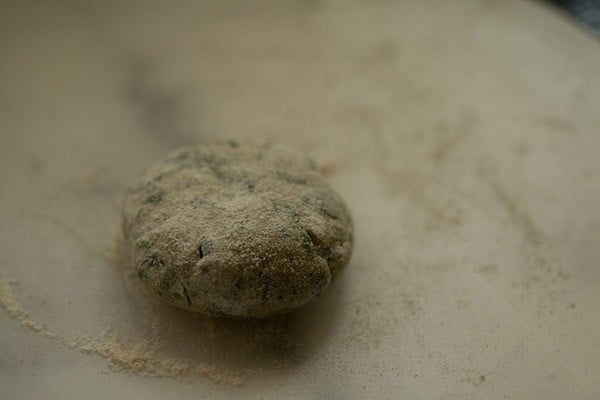
11. Use a rolling pin to flatten.

12. Roll the dough to a round flatbread of about 7 to 8 inches in diameter.
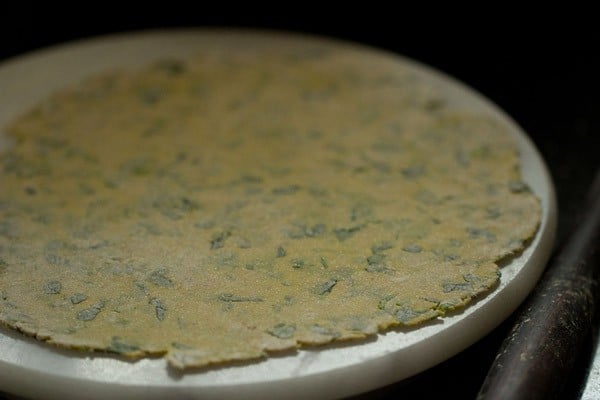
Cook Methi Thepla
13. Heat a tawa or large skillet over medium-high heat. Once hot, place the flattened and rolled dough onto the surface.
Let cook for under a minute until just starting to become light golden or you see faint air pockets on the top.
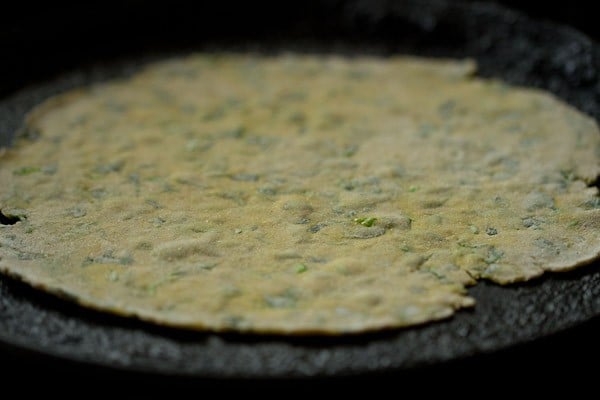
14. Use a spatula to flip.
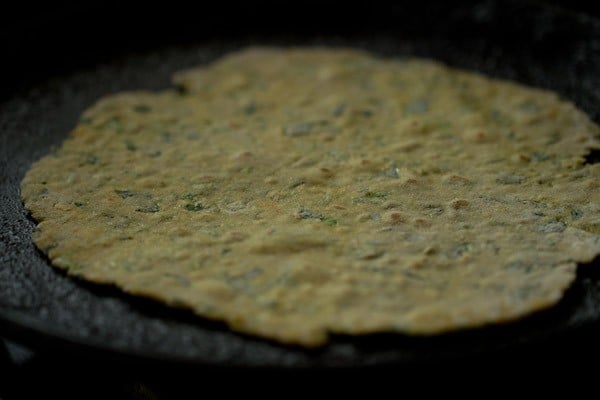
15. Spread oil lightly on the top side to coat, like in the picture below.
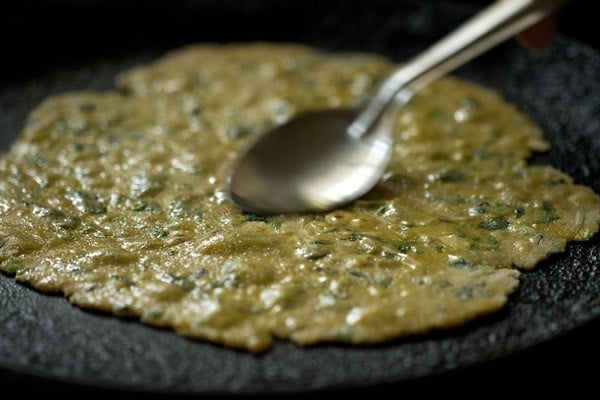
16. Flip the thepla again when the second side is half-cooked.
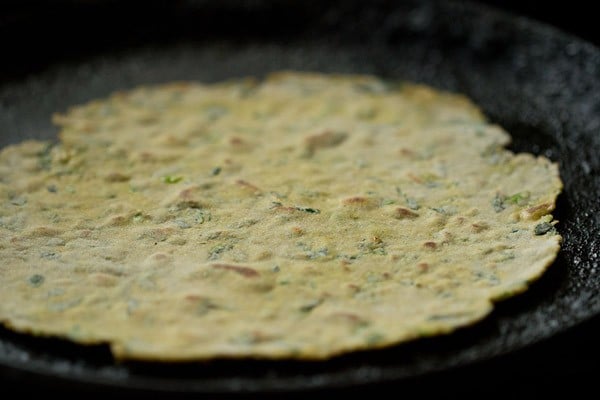
17. Now spread a bit of oil on this side, too.
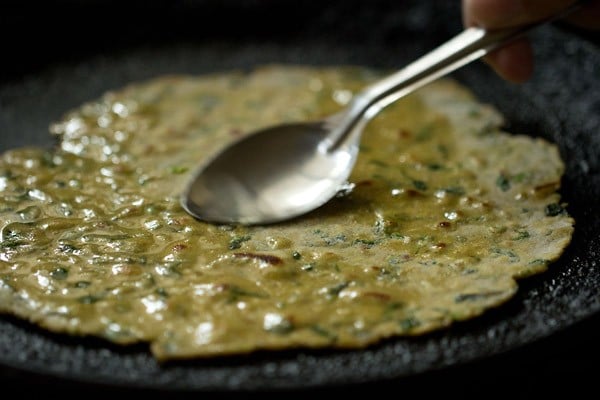
18. Continue to flip back and forth a couple of times, allowing the thepla to cook for just under a minute or so each time until the flatbread becomes golden brown with even, slightly darker brown spots.
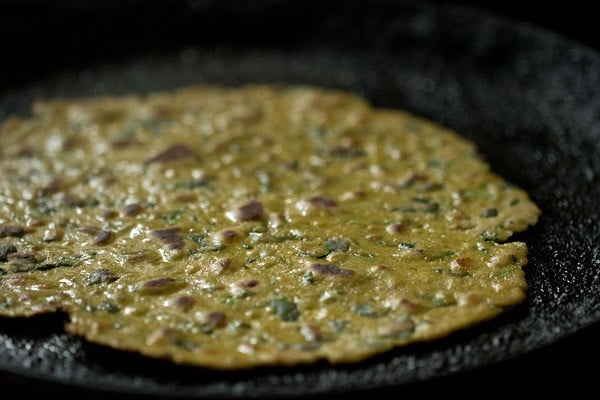
19. If needed you can press the thepla with spatula to get an even cook.
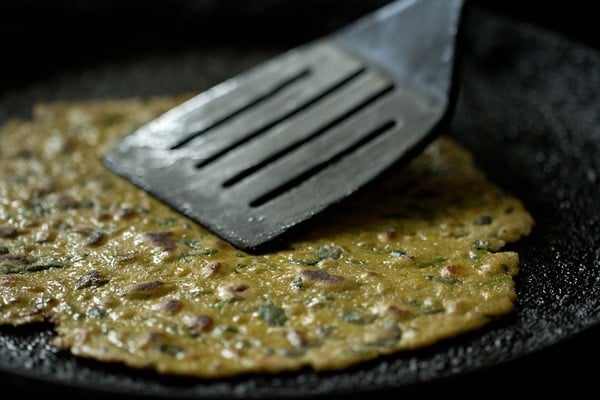
20. Note: Since I plan to serve them after a few hours, I have added a good amount of oil so that they remain soft. If you plan to serve them immediately then you can add less oil.

21. Remove the Methi Thepla from the skillet, and keep transfer to a roti basket or a covered platter to serve. Continue to make all thepla this way one by one.
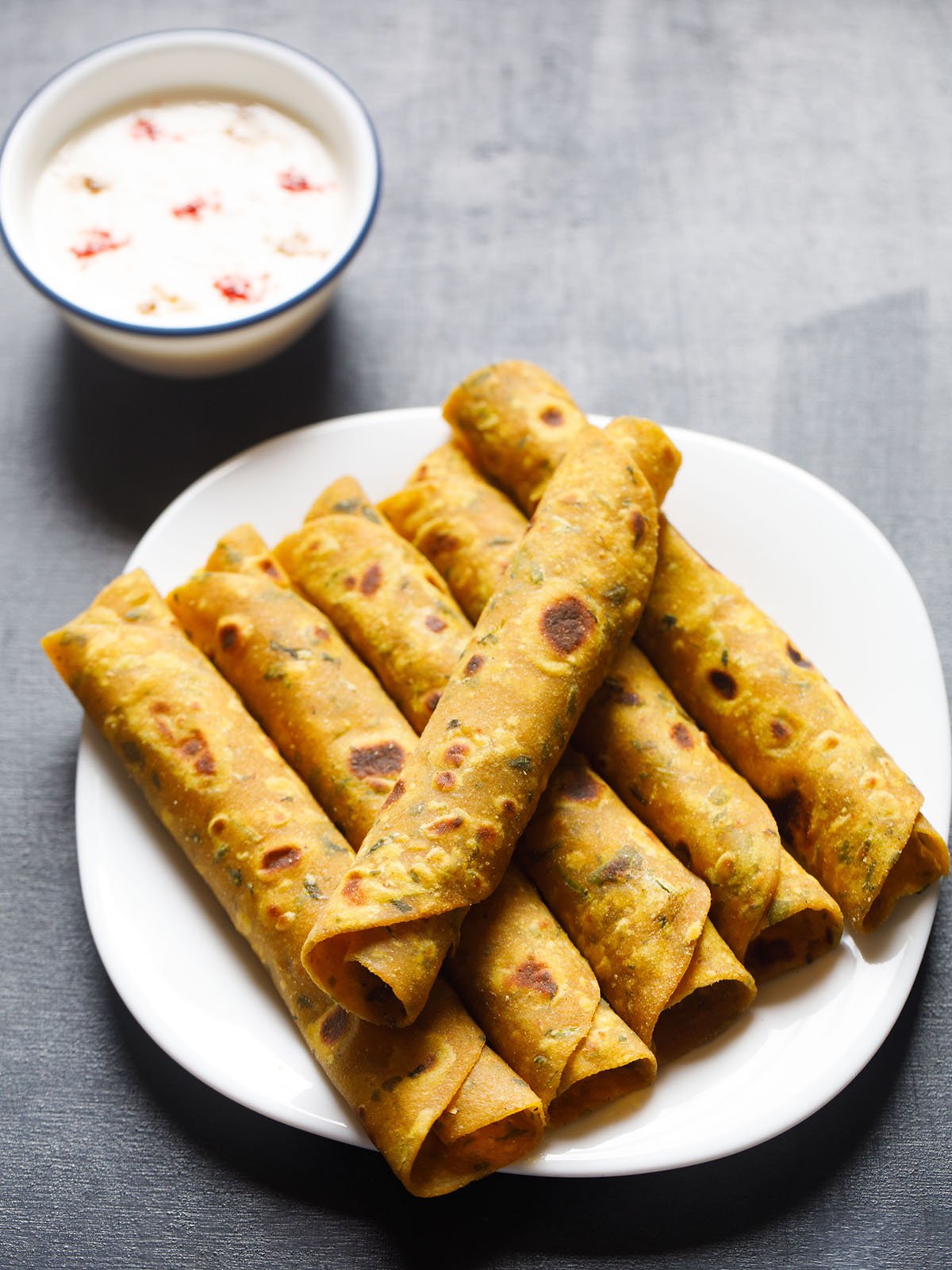
Serving Suggestions
Serve Thepla with plain curd (yogurt), lemon or Mango Pickle, Mango Chutney, or Mango Chunda. The bitterness from the fenugreek pairs perfectly with the sweetness of the mango!
You can also eat these with a simple Batata nu Shaak. These flatbreads also pair well as a side snack with Masala Chai. We also like to eat it with Dal Fry.
Storing Suggestions
Methi Thepla are best when enjoyed either right away or later the same day. They will keep well for up to 3 to 4 days when you make them without curd.
So if you want to have them later after a few days, do not add curd as it will lessen its shelf life. Simply knead the dough with water. Store cooled flatbreads in an airtight container and keep at room temperature.
They also freeze well. Simply wrap a stack of cooled methi thepla in parchment before storing in an airtight freezer bag, and keep in the freezer for up to 1 month.
Thaw in the fridge and later reheat these flatbreads either in a skillet on the stove or in the oven for just a few minutes until warm.
Variations
There are many variations of making thepla recipe and each family has their own method and proportions of flours that they add. Make a plain thepla recipe or add a few veggies that make them healthier. I have shared a few variations and have listed them below.
- Lauki Thepla: I make these soft flatbreads with bottle gourd (opo squash, calabash). My lauki thepla recipe is different from methi thepla wherein I do not include millet flours but only add whole wheat flour and gram flour.
- Mooli Thepla: These rustic flatbreads made with tender white radish (mooli), whole wheat flour and spices are simply delicious. Both mooli thepla and mooli paratha are different unique recipes. To make mooli thepla mix the radish with the flour and then knead to a soft dough. But to make paratha, you stuff the grated radish as a separate layer in the rolled dough.
- Plain Thepla: Make the simplest version of plain thepla recipe without any vegetables. Omit fenugreek leaves in this recipe. Add some water to knead the dough. You can also omit the millet flours and include 1½ cups of whole wheat flour and ¼ cup of gram flour.
- With Kasuri Methi: We call dried fenugreek leaves ‘Kasuri Methi’ in Hindi. These dried fragrant leaves come in handy when you do not have fresh leaves. You can replace fresh methi leaves with Kasuri Methi in this recipe – simply add about 2 to 3 tablespoons. Add some water as needed while kneading.
- Other Greens: You can make this thepla recipe with green leafy vegetables like spinach or amaranth leaves.
Expert Tips
- Flours: You can include various combinations of flours with different ratios. However, always add more whole wheat flour. With lesser amounts of wheat flour, your flatbreads can become chewy or hard and you won’t be able to roll the dough easily. A relevant point to be remembered is not to increase the amount of gram flour (besan) too much. This can make the texture hard and dry.
- Dough Consistency: The dough has to be smooth, soft, and pliable. If your dough looks hard, the texture will become dry and hard. With a soft and sticky dough, you won’t be able to roll evenly and it may tear. To correct hard dough, add a few tablespoons of curd or water and knead. For a sticky dough, add some wheat flour.
- Longer Storage: If you want to make flatbreads for a journey or you plan to store it for some days. Then add about 3 to 4 tablespoons of oil to the flour, while you form the dough. Not only adding oil will make the texture soft but also help in preserving them for some days. Omit to add the curd (yogurt) as it decreases the shelf life of these flatbreads.
- Spicing: For a spicy version add more green chilies and red chili powder. You can always add less or more ground spices and green chilies according to your preferences.
- Fats: For roasting thepla, you may use ghee (clarified butter) instead of oil.
FAQs
Firstly, Methi Paratha is from Punjabi or North Indian cuisine and Methi Thepla is a specialty of Gujarati cuisine. In Methi Thepla, millet flours may also be added along with whole wheat flour whereas the Methi Paratha is solely made with whole wheat flour. Some spice powders are also common in the thepla recipe, which are usually missing from the paratha version.
Yes, you definitely can. Substitute the methi leaves with other leafy greens like fresh amaranth leaves, moringa leaves, malabar spinach or fresh spinach leaves.
The dough for Thepla recipe has to be kneaded to a soft, smooth and pliable consistency. With a hard dough you will get a dry & chewy texture . A sticky and soft dough is difficult to roll evenly and may tear as well. Adjust a hard dough by adding a few tablespoons of curd (yogurt) and then knead it. Correct a sticky dough by adding some wheat flour.
Yes, it is. But in that case, there will be no major difference between this and a Punjabi paratha. So, for the typical flavors, do include the ground spices too in the recipe. The quantities can be adjusted as per your palate preferences.
More Similar Recipes To Try!
Indian Breads
Indian Breads
Indian Breads
Indian Breads
If you’ve tried this recipe, please rate it in the recipe card or leave a comment below – I’d love to hear your feedback. For more vegetarian inspiration, sign up for my email updates or follow me on Instagram, Youtube, Facebook, Pinterest or X.
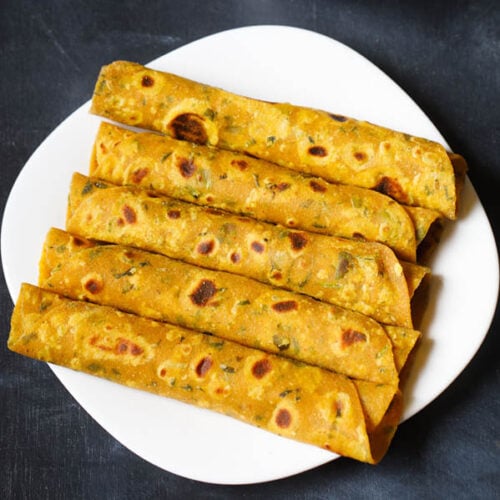
Thepla Recipe (Multigrain Methi Thepla)
Ingredients
- 1 cup fenugreek leaves (fresh methi) – tightly packed
- 1 cup or (120 grams) whole wheat flour
- ¼ cup or (40 grams) gram flour (besan)
- ¼ cup or (40 grams) pearl millet flour (bajra flour)
- ¼ cup or (40 grams) sorghum flour (jowar flour)
- 1 inch ginger – crushed to a paste
- ½ to 1 teaspoon green chillies – chopped, crushed to a paste
- ½ teaspoon Red Chili Powder or cayenne pepper
- ½ teaspoon turmeric powder
- ½ teaspoon Cumin Powder (ground cumin)
- ½ teaspoon Coriander Powder (ground coriander)
- ¾ teaspoon salt or add as required
- 1 tablespoon oil
- 4 to 5 tablespoon Curd (yogurt) or water for kneading or add as required
- oil as required for roasting thepla
Instructions
Kneading dough
- Rinse the methi leaves in running water a few times getting rid of any dirt or mud clinging on them. Then drain them really well and chop finely.
- In a mixing bowl, take whole wheat flour, gram flour, sorghum flour and pearl millet flour. I have used millet flours but you can skip them if you don't have. In this case, simply add 1.25 cups whole wheat flour and ½ cup besan.
- Add all the ginger and green chilli paste, followed by the spice powders – red chilli powder, turmeric powder, cumin powder, coriander powder.
- Season with salt. Add 1 tablespoon oil.
- Add the finely chopped fenugreek leaves. Mix everything well.
- Add curd or yogurt. For a vegan option add very little water instead of curd.
- Mix again and knead into a dough. Don't add water while kneading as methi leaves will release water.
- Knead to a soft and smooth dough. Add more curd if needed while kneading.
Rolling to flatbreads
- Make medium sized balls from the dough.
- Take a medium sized ball and sprinkle some flour on it.
- With the rolling pin begin to roll the dough to a round or disc of about 7 to 8 inches in diameter.
Cooking thepla
- On a hot tawa or skillet, place the rolled dough. Flip when one side is partly cooked, about one-fourth or half cooked. You will see some faint air pockets on the top and this is the time when you need to flip it.
- Spread oil on this side. Flip the thepla again when the second side is half-cooked.
- Now spread the oil on this side. Flip a couple of times till you get golden spots and the methi thepla is cooked evenly.
- You can also press the thepla with spatula while cooking.
- Remove and keep it in a roti basket.
- Serve Methi Thepla hot or warm or at room temperature.
Serving suggestions
- Enjoy Thepla with plain curd (yogurt), lemon or Mango Pickle, Mango Chutney, or Mango Chunda.
- You can also eat these with a simple Batata nu Shaak. These flatbreads also pairs well as a side snack with Masala Chai or Ginger Chai.
Storage
- Methi Thepla are best when enjoyed either right away or later the same day. They will keep well for up to 3 to 4 days when you make them without curd.
- So if you want to have them later after a few days, do not add curd as it will lessen its shelf life. Simply knead the dough with water. Store cooled flatbreads in an airtight container and keep at room temperature.
- They also freeze well. Simply wrap a stack of cooled Thepla in foil before storing in an airtight freezer bag, and keep in the freezer for up to 1 month.
- Thaw in the fridge and later reheat these flatbreads either in a skillet on the stove or in the oven for just a few minutes until warm.
Video
Notes
- Flours: You can include various combinations of flours with different ratios. However, always add more whole wheat flour. With lesser amounts of wheat flour, the texture can become chewy or hard and you won’t be able to roll the dough easily. A relevant point to be remembered is not to increase the amount of gram flour (besan) too much. This can make the texture hard and dry.
- Dough consistency: The dough has to be smooth, soft, and pliable. If your dough looks hard, the texture will become dry and hard. With a soft and sticky dough, you won’t be able to roll evenly and it may tear. To correct hard dough, add a few tablespoons of curd or water and knead. For a sticky dough, add some wheat flour.
- Longer storage: If you want to make these flatbreads for a journey or you plan to store it for some days. Then add about 3 to 4 tablespoons of oil to the flour, while you form the dough. Not only adding oil will make thepla soft but also help in preserving them for some days. Omit to add the curd (yogurt) as it decreases the shelf life of thepla.
- Spicing: For a spicy version add more green chilies and red chili powder. You can always add less or more ground spices and green chilies according to your preferences.
- Fats: For roasting, you may use ghee (clarified butter) instead of oil.
- Other Greens: You can make this recipe with green leafy vegetables like spinach, moringa leaves or amaranth leaves.
Nutrition Info (Approximate Values)
Thepla recipe from the archives was first published on July 2012.
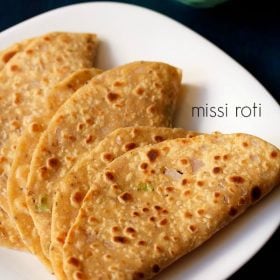
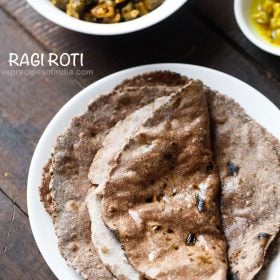
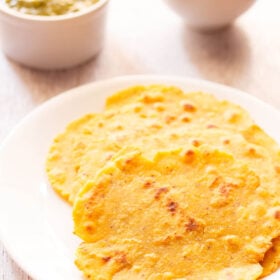
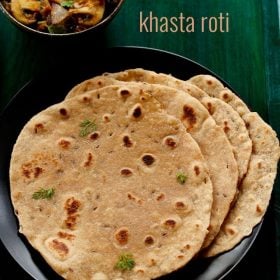
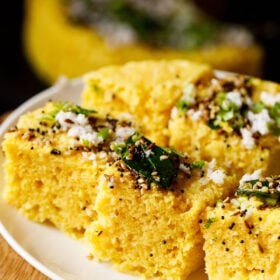
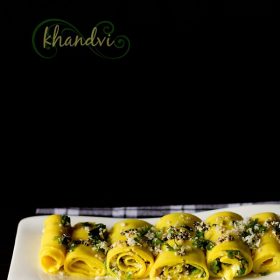
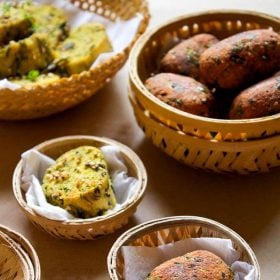
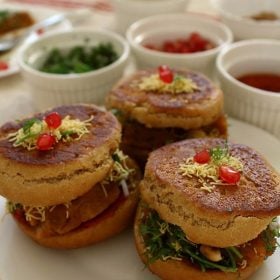








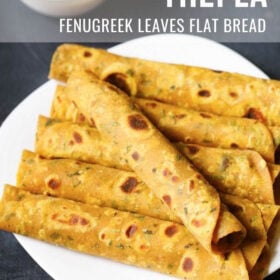
Great recipe and easy to follow.
Can we mix the dry flours and store them to use whenever we want?
Yes, you can do that.
Thanks for this website which is a great resource for me living in the UK. I have learnt a lot of new recipes, they are very clearly written and come out well. Keep up the good work!
Thanks a lot and glad!
Hi, I love all your recipe especially this one. I want to try with whole wheat flour, ragi and besan. Can you help me with the proportion. Thank you in advance
Thanks Sejal. You can try with 1 cup whole wheat flour, ¼ cup ragi flour and ¼ cup besan. Welcome.
Excellent recipe.!! Absolutely fabulous taste, all your recipes are great.
Thank you so much. Glad you liked the methi thepla recipe.
Can I use dry methi leaves. We don’t get fresh methi out here
Yes, you can add 1 to 2 tablespoons of dried methi leaves.
Yep you definitely can. I always make with dried leaves due to lack of availability of fresh leaves.
If i add spinach, should I cook it first and squeeze out the liquid? How much spinach could I add? Thanks!
No need to cook them first. Just add finely chopped fresh spinach and reduce the amount of water. You can add 1 cup.
Successful.
Thanks for the quick response. i made rotis today as advised by you and they were really nice and soft.
welcome winnie and thank you for letting me know.
All your recipes are simply amazing and turn out tasty. this recipe with different flours was too good. loved it with plain curds.
Rotis/ parathas are a regular fare at home. i do not use multigrain atta but get ragi,jowar and bajra ground separately. please advise me as to the correct proportion of these flours to be used along with wheat flour to make 12 to 15 rotis. thanks.
thanks winnie. i also do not use multigrain atta. i mix the individual flours and then use them. to make roti with these flours, atta always has to be more, so that it is easy to roll the roti. add hot water when mixing and kneading the dough. this will soften the jowar, bajra flours etc and make for a soft roti. the hardness or chewiness will not be felt. so if making 12 to 15 roti, you can use ¼ cup each of ragi, jowar, bajra flour and 2 to 2.25 cups of whole wheat flour. hope this helps.
You are awesome. Love your site. Keep it up. God bless you
thanks a lot soviya for your kind wishes. wish you all the best.
Every time when I have had to look up for a recipe at the last moment, this website has come up as a savior and has been the best guiding point each time helping me to sail through the doubts and prepare the dish well. Thank you for making this website, the description with pictures is so helpful, each step so well put that it’s very clear to understand. Very detailed, precise and clear description. Love to visit this website. Thanks again, keep up the awesome work! Loads of love and good luck 🙂
thank you very much nidhi. i feel good to know that the detailed description, step wise photos and tips are helpful. hugs and wish you all the best. happy cooking.
If I have to search any recipe on the Internet – this is my go to place. Never once have your recipes gone wrong! Keep doing the good work you do! And thank you for maintaining this website.
welcome rashmi and thank you for this comment. so glad to read and i am happy that the recipes are turning good for you. thanks again.
This recipe is amazing! My mum and I made this for lunch today and paired it with a simple raita. Sooo good!
thanks saritha for the feedback and rating. yes methi thepla tastes good and can be had with a pickle or raita.
Your recipes are very simple to follow and it turns out very tasty. Thanks for sharing yummy recipes. I love cooking and like trying different recipes.
thanks zeenat for this feedback. same here and i too love cooking.
Can I make it with kasuri methi as I dont have fresh methi leaves?
yes you can use kasuri methi. you can add 1 to 2 tablespoons of kasuri methi.